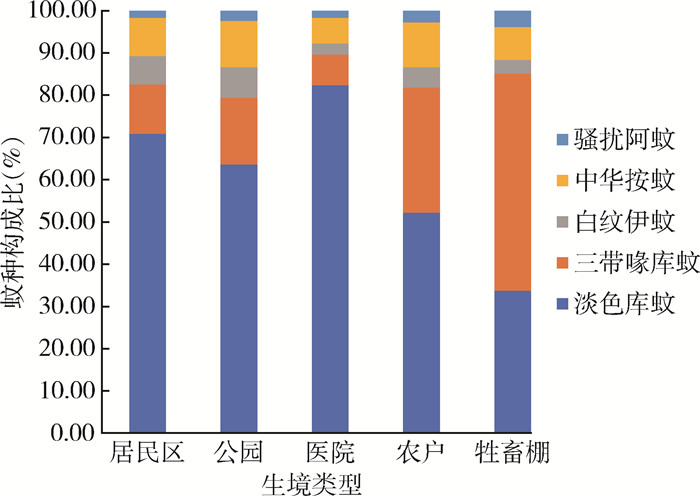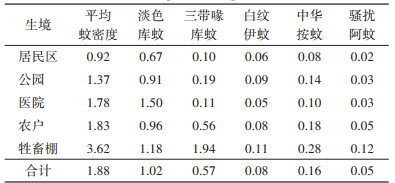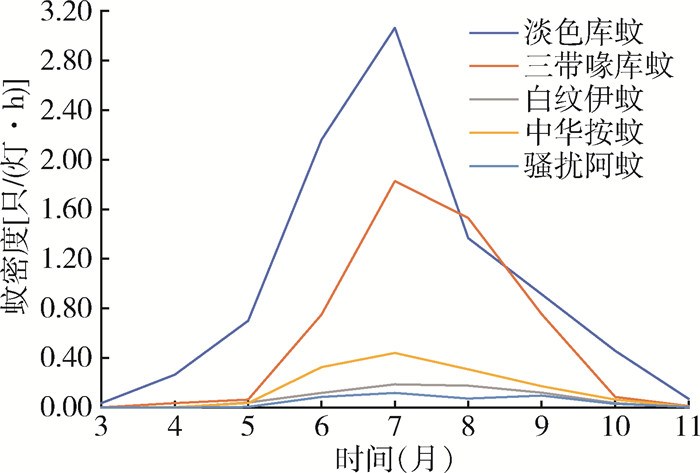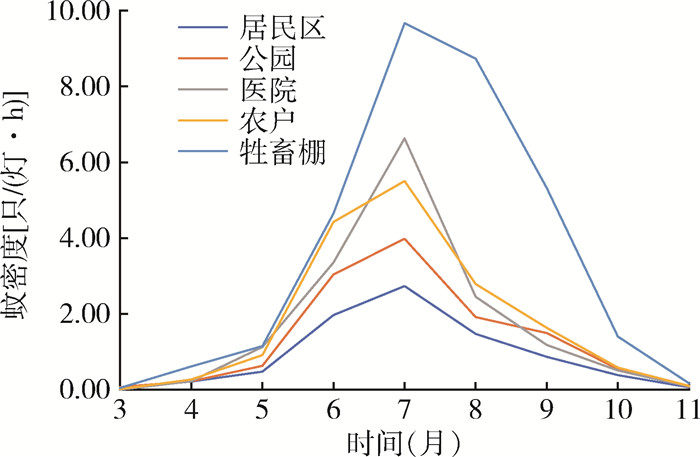扩展功能
文章信息
- 周小青, 陈夕鹏, 吕蒙蒙, 朱海洋, 罗晶, 唐勇, 蔡蓉
- ZHOU Xiao-qing, CHEN Xi-peng, LYU Meng-meng, ZHU Hai-yang, LUO Jing, TANG Yong, CAI Rong
- 江苏省淮安市2018-2022年成蚊种群密度与季节消长监测分析
- Adult mosquito population density and seasonal fluctuation in Huai'an, Jiangsu Province, China, 2018-2022
- 中国媒介生物学及控制杂志, 2023, 34(4): 497-500
- Chin J Vector Biol & Control, 2023, 34(4): 497-500
- 10.11853/j.issn.1003.8280.2023.04.010
-
文章历史
- 收稿日期: 2023-02-23
蚊虫是一类重要媒介生物,可以携带并传播多种病原体,包括寨卡病毒、黄热病毒、基孔肯雅病毒、登革病毒、西尼罗病毒、引起丝虫病的丝虫以及疟疾病原体疟原虫等[1]。随着国际交流越来越频繁和气候变化,蚊媒传染病的防治迎来新的挑战[2]。蚊虫防制是预防和控制蚊媒传染病传播的重要措施,生态学监测更是蚊虫防制的基础。淮安市地处江苏省北部中心地域,对外交流十分频繁,同时淮安市位于淮河下游,植被丰富,气候宜人,蚊虫种类多样。为掌握淮安市蚊种构成、种群密度和季节消长等特征,我们按照江苏省制定的病媒生物监测方案开展成蚊生态学监测工作,分析淮安市2018-2022年成蚊监测数据,为下一步淮安市蚊虫和蚊媒传染病防治提供科学依据。
1 材料与方法 1.1 数据来源淮安市2018-2022年全市各监测点报送的成蚊密度监测数据。
1.2 监测方法按照《江苏省病媒生物监测方案》的成蚊监测方案,采用诱蚊灯法,分别在淮安市8个县(区)选取城镇居民区、公园、医院、农户和牲畜棚5种生境,从日落前1 h开始至次日日出后1 h接通电源进行诱蚊。每年3-11月开展监测,每月监测2次,2次监测时间间隔不少于10 d。蚊密度计算公式:

|
采用Excel 2019和SPSS 26.0软件进行数据整理和分析。χ2检验比较不同年份、不同生境蚊种构成比,Welch方差分析比较不同生境的蚊密度,以P < 0.05为差异有统计学意义。
2 结果 2.1 年际蚊种构成及密度2018-2022年淮安市共布放诱蚊灯4 733台,捕获成蚊122 592只,总密度为1.88只/(灯·h)。2019年蚊密度最高,为2.16只/(灯·h),2020年蚊密度最低,为1.44只/(灯·h)。其中捕获淡色库蚊(Culex pipiens pallens)66 363只,占捕获总数的54.13%,为优势蚊种;其他蚊种依次为三带喙库蚊(Cx. tritaeniorhynchus)、中华按蚊(Anopheles sinensis)、白纹伊蚊(Aedes albopictus)和骚扰阿蚊(Armigeres subalbatus),分别占29.97%、8.65%、4.47%和2.78%。经χ2检验,各蚊种不同年份之间的构成比差异均有统计学意义(均P < 0.001)。其中疟疾传播媒介之一中华按蚊的构成比在逐年上升。见表 1。

|
淮安市2018-2022年居民区、公园、医院、农户这4类生境中捕获蚊种均以淡色库蚊为主,构成比分别为70.87%、63.66%、82.43%和52.23%,而牲畜棚捕获蚊种主要为三带喙库蚊,占51.41%。不同生境蚊种构成比差异有统计学意义(χ2=22 424.835,P < 0.001)(图 1)。不同生境蚊密度以牲畜棚最高,为3.62只/(灯·h),农户次之,为1.83只/(灯·h),居民区蚊密度最低,为0.92只/(灯·h)。对各生境蚊密度进行Welch方差分析,发现不同生境之间蚊密度差异亦有统计学意义(F=5.843,P=0.013)。居民区、公园、医院和农户4类生境中均以淡色库蚊密度最高,而牲畜棚中三带喙库蚊密度则高于淡色库蚊,为1.94只/(灯·h)。三带喙库蚊、白纹伊蚊、中华按蚊和骚扰阿蚊在牲畜棚中密度均高于其他生境,淡色库蚊在医院中密度最高,为1.50只/(灯·h)。见表 2。

|
| 图 1 2018-2022年江苏省淮安市不同生境蚊虫种类构成 Figure 1 The mosquito species composition ratios of different habitats in Huai'an, Jiangsu Province, 2018-2022 |
| |

|
2018-2022年淮安市蚊密度季节消长变化均表现为单峰型,6-9月为蚊虫活跃期,蚊密度相对较高。2019、2020和2022年每年的7月蚊密度达到峰值,蚊密度分别为6.90、4.52和8.79只/(灯·h),而2018年蚊密度在8月达到高峰,为5.80只/(灯·h),2021年蚊密度则在6月达到高峰,为8.67只/(灯·h)(表 3)。各蚊种密度季节消长变化均呈单峰型且均在7月到达峰值,蚊密度由高到低依次为淡色库蚊、三带喙库蚊、中华按蚊、白纹伊蚊和骚扰阿蚊,分别为3.06、1.83、0.44、0.19和0.12只/(灯·h)(图 2)。在不同生境,淮安市2018-2022年蚊密度季节消长均呈现单峰型,且峰值均出现在7月。居民区、公园、医院、农户和牲畜棚7月蚊密度分别为2.73、3.98、6.63、5.51和9.67只/(灯·h)。见图 3。

|

|
| 图 2 2018-2022年江苏省淮安市不同蚊种密度季节消长 Figure 2 The seasonal fluctuation of density of different mosquito species in Huai'an, Jiangsu Province, 2018-2022 |
| |

|
| 图 3 2018-2022年江苏省淮安市不同生境蚊密度季节消长 Figure 3 The seasonal fluctuation of mosquito density in different habitats in Huai'an, Jiangsu Province, 2018-2022 |
| |
2018-2022年淮安市诱蚊灯法监测的成蚊总体密度为1.88只/(灯·h),与2017年淮安市成蚊密度[1.74只/(灯·h)]相比略有上升,但整体均处于较低水平[3]。2020-2022年新型冠状病毒肺炎疫情期间,部分监测工作未能按照计划时间执行,布灯数和捕蚊时间有所减少,可能对监测结果产生一定程度的影响。淮安市成蚊生态学监测到的蚊种分别为淡色库蚊、三带喙库蚊、白纹伊蚊、中华按蚊和骚扰阿蚊,与王巧燕等[4]对上海市嘉定区2018-2020年成蚊生态学监测结果一致。淡色库蚊是我国的优势蚊种[5],2018-2022年间淮安市捕获淡色库蚊占捕获总数的54.13%,整体高于其他蚊种。其中2018年三带喙库蚊占比(45.46%)略高于淡色库蚊(43.70%),与当时一牲畜棚监测生境环境较差,捕获大量三带喙库蚊有关,造成整体三带喙库蚊数量异常增多。同时疟疾传播媒介之一的中华按蚊在监测蚊种中所占比例逐年上升,提示在今后的工作中要加强传疟媒介按蚊生态学监测,扩大监测生境范围和时间,同时还需加强按蚊的抗药性监测,以防消除疟疾后输入性疟疾引起再传播风险。
淮安市2018-2022年成蚊生态学监测结果显示,农户和牲畜棚中蚊密度相对较高,提示农村环境存在较多蚊虫孳生场所,是蚊虫防制的重点区域,这与杨维芳等[6]、胡雅劼等[7]报道结果一致。三带喙库蚊在农户和牲畜棚中构成比及密度均相较其他生境高。杨中华和周红宁[8]研究发现三带喙库蚊主要栖息在房屋和畜圈周围的草丛中,杨维芳等[9]2006-2007年对南京市郊区牲畜棚蚊虫调查中三带喙库蚊占90.00%以上,说明农村生境是三带喙库蚊的主要孳生地,需加强对该蚊的生态学监测,预防流行性乙型脑炎的传播与流行。2018-2022年淮安市调查结果显示,淡色库蚊在医院中构成比及密度最高,与王巧燕等[4]结果一致。不同蚊种的生活习性不同,孳生的环境也各不相同,进而影响蚊密度[10]。2018-2022年间淮安市监测到的白纹伊蚊构成和密度相对较低,平均密度仅为0.08只/(灯·h)。闫冬明等[11]指出诱蚊灯对夜间活动的中华按蚊、淡色库蚊和三带喙库蚊等引诱效果较好,而对白纹伊蚊的引诱效果较差。李旭龙等[12]研究发现诱蚊灯法捕获蚊虫种类最多,以淡色库蚊为主,而人诱法所获蚊虫以攻击力最强的白纹伊蚊为主。马德珍等[13]研究也发现,相较于BG-trap诱捕器,诱蚊灯对于白纹伊蚊的捕获效率很低。因此在进行登革热媒介伊蚊监测时,不建议使用诱蚊灯法。
2018-2022年淮安市蚊密度季节消长变化均表现为单峰型,6-9月为蚊虫活跃期,大多数年份在7月蚊密度最高。6-9月淮安市气温较高,雨水相对较充沛,适合蚊虫孳生。不同蚊种、不同生境季节消长趋势均呈单峰分布,平均密度顶峰均出现在7月。杨维芳等[6]对江苏省2008-2018年蚊虫种群消长研究中指出,3-11月城区、农村和全省蚊密度均表现为单峰型消长,5-7月是蚊密度快速上升期,密度最高峰出现在7月。赵宁等[5]在2019年全国媒介蚊虫监测报告也指出,各蚊种的高峰活动季节集中在6-9月。本研究提示蚊虫活动活跃的6-9月是对其防治的关键时期,在此期间需要做好蚊虫防制工作。
利益冲突 无
| [1] |
刘起勇. 新时代媒介生物传染病形势及防控对策[J]. 中国媒介生物学及控制杂志, 2019, 30(1): 1-6, 11. Liu QY. Epidemic profile of vector-borne diseases and vector control strategies in the new era[J]. Chin J Vector Biol Control, 2019, 30(1): 1-6, 11. DOI:10.11853/j.issn.1003.8280.2019.01.001 |
| [2] |
Bai L, Morton LC, Liu QY. Climate change and mosquito-borne diseases in China: A review[J]. Global Health, 2013, 9: 10. DOI:10.1186/1744-8603-9-10 |
| [3] |
蔡蓉, 邵宗贤, 苏琦, 等. 淮安市2017年蚊生态学及抗药性调查[J]. 中华卫生杀虫药械, 2019, 25(2): 116-118. Cai R, Shao ZX, Su Q, et al. The ecology and insecticide resistance of mosquitoes in Huai'an city in 2017[J]. Chin J Hyg Insect Equip, 2019, 25(2): 116-118. DOI:10.19821/j.1671-2781.2019.02.007 |
| [4] |
王巧燕, 王韶华, 武峥嵘, 等. 上海市嘉定区2018-2020年成蚊生态学监测研究[J]. 中国媒介生物学及控制杂志, 2022, 33(3): 346-350. Wang QY, Wang SH, Wu ZR, et al. Ecological surveillance of adult mosquitoes in Jiading district, Shanghai from 2018 to 2020[J]. Chin J Vector Biol Control, 2022, 33(3): 346-350. DOI:10.11853/j.issn.1003.8280.2022.03.006 |
| [5] |
赵宁, 郭玉红, 吴海霞, 等. 2019年全国媒介蚊虫监测报告[J]. 中国媒介生物学及控制杂志, 2020, 31(4): 395-400. Zhao N, Guo YH, Wu HX, et al. National vector surveillance report on mosquitoes in China, 2019[J]. Chin J Vector Biol Control, 2020, 31(4): 395-400. DOI:10.11853/j.issn.1003.8280.2020.04.003 |
| [6] |
杨维芳, 张育富, 刘大鹏, 等. 江苏省2008-2018年蚊虫种群消长研究[J]. 中国媒介生物学及控制杂志, 2021, 32(1): 45-51. Yang WF, Zhang YF, Liu DP, et al. A study of mosquito population variation in Jiangsu province, China, 2008-2018[J]. Chin J Vector Biol Control, 2021, 32(1): 45-51. DOI:10.11853/j.issn.1003.8280.2021.01.009 |
| [7] |
胡雅劼, 张镇川, 李玲玲, 等. 四川省2017-2021年成蚊生态学特征分析[J]. 中国媒介生物学及控制杂志, 2023, 34(1): 44-47. Hu YJ, Zhang ZC, Li LL, et al. Analysis of adult mosquito bionomic characteristics in Sichuan province, China, 2017-2021[J]. Chin J Vector Biol Control, 2023, 34(1): 44-47. DOI:10.11853/j.issn.1003.8280.2023.01.008 |
| [8] |
杨中华, 周红宁. 云南省三带喙库蚊生物学习性研究进展[J]. 中国媒介生物学及控制杂志, 2018, 29(4): 403-406. Yang ZH, Zhou HN. Progress on investigation of Culex tritaeniorhynchus biological habit in Yunnan province[J]. Chin J Vector Biol Control, 2018, 29(4): 403-406. DOI:10.11853/j.issn.1003.8280.2018.04.022 |
| [9] |
杨维芳, 孙俊, 徐燕, 等. 三带喙库蚊发生量与气象因子相关性初步分析[J]. 中国媒介生物学及控制杂志, 2010, 21(1): 49-50. Yang WF, Sun J, Xu Y, et al. A preliminary study on the relationship between occurrence of Culex tritaeniorhynchus and meteorological factors[J]. Chin J Vector Biol Control, 2010, 21(1): 49-50. |
| [10] |
Chuang TW, Hildreth MB, Vanroekel DL, et al. Weather and land cover influences on mosquito populations in Sioux Falls, South Dakota[J]. J Med Entomol, 2011, 48(3): 669-679. DOI:10.1603/ME10246 |
| [11] |
闫冬明, 黄坤, 赵春春, 等. 常用蚊虫监测方法和技术研究进展[J]. 中国媒介生物学及控制杂志, 2020, 31(1): 108-112. Yan DM, Huang K, Zhao CC, et al. Research advances in common methods and techniques for mosquito surveillance[J]. Chin J Vector Biol Control, 2020, 31(1): 108-112. DOI:10.11853/j.issn.1003.8280.2020.01.023 |
| [12] |
李旭龙, 张宝芳, 张铮, 等. 2006-2009年宝鸡市蚊虫密度及不同监测方法比较研究[J]. 中国媒介生物学及控制杂志, 2010, 21(6): 592-595. Li XL, Zhang BF, Zhang Z, et al. Study on the different methods of mosquito monitoring and its density in Baoji from 2006 to 2009[J]. Chin J Vector Biol Control, 2010, 21(6): 592-595. |
| [13] |
马德珍, 明明, 陆华. 光催化诱蚊灯与BG-trap捕蚊器诱蚊效果比较研究[J]. 中国媒介生物学及控制杂志, 2020, 31(6): 685-689. Ma DZ, Ming M, Lu H. Mosquito-trapping effect of photocatalysis mosquito lamp versus BG-trap mosquito lamp[J]. Chin J Vector Biol Control, 2020, 31(6): 685-689. DOI:10.11853/j.issn.1003.8280.2020.06.012 |
 2023, Vol. 34
2023, Vol. 34


